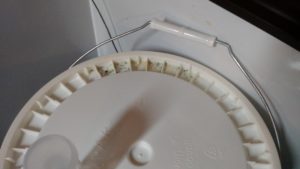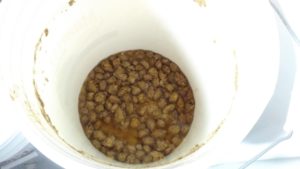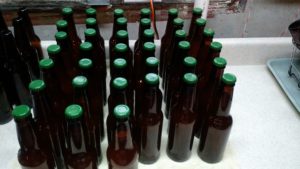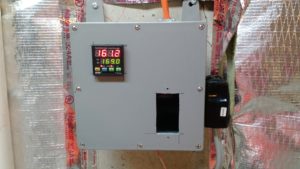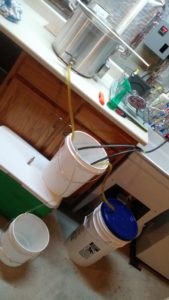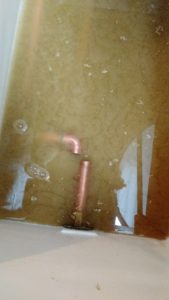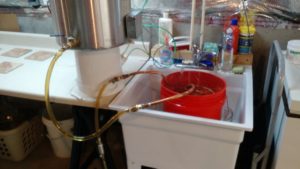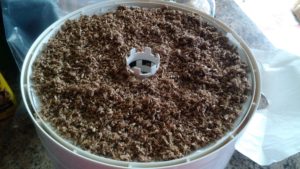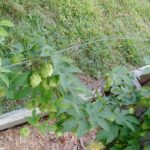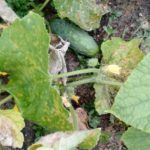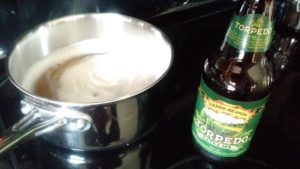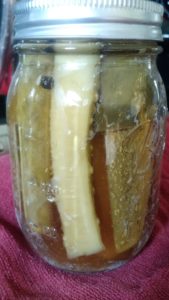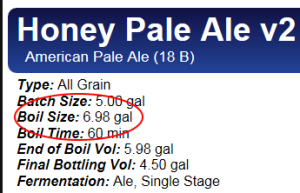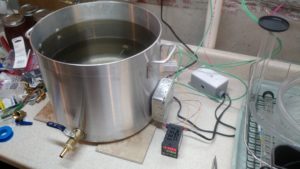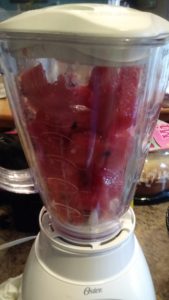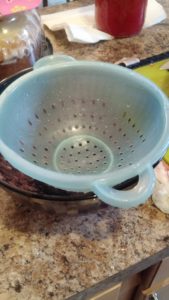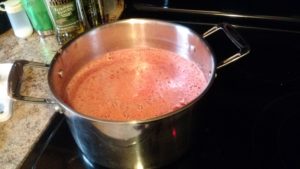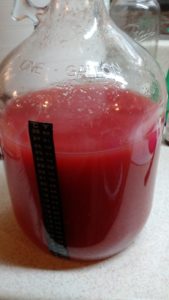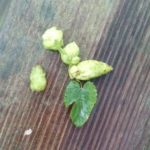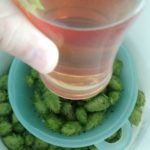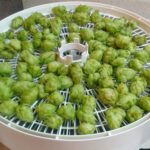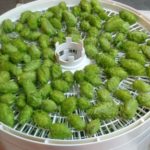Latest Posts
IPA Bottled… God, I Hate Bottling. And Mold.
I had this IPA sitting in the fermenter a week longer than I anticipated. It had to be bottled this week, though – next week is likely going to be busy (I’m volunteering with the Cincinnati Queen Bee Half Marathon for part of Saturday, and Sunday will likely be busy with family). This is a somewhat fitting end to a great weekend… well, the lovely citrus hop aromas was a fitting end, the rest, not so much.
Friday kicked off with Pint Night courtesy of my wife asking for Woodchuck Harvest Cider. The featured brewery was 5 Rabbit Cerveceria, and in attendance was Randy Mosher (partner and creative director at 5 Rabbit). I got to talk to Randy for a few minutes, which was awesome since I’ve read two of his books. I found out he went to the University of Cincinnati College of Design, Architecture, Art, and Planning (DAAP) “when it was just DAA, before the P”. I told him I went there for urban planning, in DAAP, after they added the P. It was a true beer geek moment, and I was savoring it with their Yodo con Leche, which is among the best beers I’ve tasted!
Saturday, my wife arranged for her parents to babysit the kids and we went to Rivertown Brewery and Barrelhouse. We arrived just behind a bus full of beer geeks. Initially I was concerned that getting a flight and a seat would be an issue, but fortunately neither was an issue, and we ended up having a nice conversation with a couple that were on the bus.
Sunday began with a little bit of NFL from London and me beginning bottling.
Things were a little more difficult this time because of mold. Part of me wants to blame HBF or AHA or something because one of them tweeted out something about it, but it’s really not their fault. And all this was on the outside. To add to the mold problem, I didn’t have enough corn sugar, so I decided to use math and use a partial batch of corn sugar and sucrose.
Once I boiled the sugar solution (upstairs in the kitchen) and moved it downstairs (to the brewery), I decided to wash all the bottles I was going to use. Normally I don’t because I wash all bottles before taking them into the basement, I decided a change was in order because one of my cats has taken up residence in the basement. I really don’t want cathair in my IPA. Then I had to sanitize the bottles. I don’t own a bottle tree, so dealing with bottles is a painful process of draining bottles on a dish drainer and then setting them on a towel.
I believe I was able to open the fermenter without getting any mold into the beer. This was an AWESOME smelling beer! As soon as I opened the fermenter I was greeted with citrus aromas from the citra, galaxy, and cascade hops I used. Bottling was without incident, and I now have 39 bottles of green capped goodness conditioning in my basement.
The stats:
78 IBU, 6.3%ABV, OG 1.056, FG 1.008.
Of course, this was not the end of bottling day. The mold was not only on my fermenter lid, but also in the freezer. I had to spend some time cleaning it out with antibacterial cleaner. I decided to remove the thermocouple and go with another solution. I also decided that making lagers wasn’t as important to me as not bottling anymore, and I decided I’m going to move towards kegging. I spent a large part of the afternoon on Facebook messenger pelleting a friend of mine with questions.
Cheers until next week!
Another IPA Brew Day
So I decided later than usual on a Saturday to brew. This is a brew that I wanted to do the prior weekend, but my home AC was on the fritz and adding a bunch of humidity to it would not have been a very smart move.
This was an interesting brew day for two reasons. A large portion of the brew day was spent thinking that I would be preparing to brew the following day. I built an electric panel to fix the dangerous setup I had previously.
The thing is, I didn’t have the plug on the cord from the boiler ready. Once I did that, I added water and started things up. Then I went to work on preparing the mash tun. In my last post, I had the stuck sparge from Hell. I did NOT want that happening again. I added some plumbing solder in some strategic places and scrubbed down the copper. At that point (and after messing up and fixing solder joints twice, and since leaks don’t really matter here the mess ups were pretty important to fix), I decided to go ‘all in’ and start mashing.
I love problems that fix themselves!
This brew day had one minor mess up – for my IPA, I have hops at first wort (in the kettle), 15, 5, knockout, and dry. I did first wort, 15, 10, and knockout. Oops. It also had one issue that I thought would be a huge problem – my sparge water kept heating even after the PID said things were off. I didn’t notice until the water hit 205º F, and the heat was still on despite the output light on the PID controller not being on. So I unplugged the boiler to keep the water from boiling and let it cool. Later, when it was time to heat the water back up to sparge temperatures, I plugged the boiler back in and let it heat back up. And it worked correctly. And it worked correctly through the entire boil, too. I love problems that fix themselves!
They leak
Chilling had been an issue in the past, and I still reign supreme at having the most fucked up chilling schemes. This one isn’t much different. I bought a plate chiller on Amazon a few weeks ago. The water inlets and outlets were standard hose fittings. My house is six years old, and the cheap washing machine lines were something that was on the list of things to replace. I decided to purchase new stainless steel lines for the washing machine and use the old lines for the plate chiller.
They leak. Somehow in the process of unhooking them from the back of the washing machine and the wall and putting them on the plate chiller, they decided to leak. And these weren’t leaks that could be fixed by torquing down the connectors or using pipe tape (which is unnecessary on these connectors). And I made sure the O-rings were in the hose connectors.
So I did what any sane person would do. Since I didn’t have enough hose to set the plate chiller in the sink (that would have been optimal), I put the chiller in a bucket. Which started to fill. So to avoid flooding part of my basement, I used a small hose to siphon the leaking water out of the main bucket into another so I could dump water without moving the plate chiller around.
So on the shopping list is two new hoses. Because had I had not-leaking hoses, the plate chiller would have worked very well. And even allowing a lot of the trub go through was okay (I use pellet hops). I’m not sure what temperature I got things down to. Put the ale pail into the fermentation chamber and set it to chill at about 6:30. I ended up pitching the yeast at midnight or so.
The Recipe
The recipe has changed a little. I wanted it a little less malty and a little more crisp.
Recipe Details
| Batch Size | Boil Time | IBU | SRM | Est. OG | Est. FG | ABV |
|---|---|---|---|---|---|---|
| 5 gal | 60 min | 71.4 IBUs | 5.4 SRM | 1.070 | 1.013 | 7.6 % |
| Actuals | 1.051 | 1.01 | 5.4 % | |||
Style Details
| Name | Cat. | OG Range | FG Range | IBU | SRM | Carb | ABV |
|---|---|---|---|---|---|---|---|
| American IPA | 14 B | 1.056 - 1.075 | 1.01 - 1.018 | 40 - 70 | 6 - 15 | 2.2 - 2.7 | 5.5 - 7.5 % |
Fermentables
| Name | Amount | % |
|---|---|---|
| Pale Malt (2 Row) US | 7 lbs | 50 |
| Vienna Malt | 6 lbs | 42.86 |
| Cara-Pils/Dextrine | 1 lbs | 7.14 |
Hops
| Name | Amount | Time | Use | Form | Alpha % |
|---|---|---|---|---|---|
| Cascade | 2 oz | 15 min | First Wort | Pellet | 6.6 |
| Cascade | 0.5 oz | 15 min | Boil | Pellet | 6.6 |
| Citra | 0.5 oz | 15 min | Boil | Pellet | 12 |
| Galaxy | 0.5 oz | 15 min | Boil | Pellet | 11 |
| Cascade | 0.5 oz | 5 min | Boil | Pellet | 6.6 |
| Citra | 0.5 oz | 5 min | Boil | Pellet | 12 |
| Galaxy | 0.5 oz | 5 min | Boil | Pellet | 11 |
| Cascade | 1 oz | 15 min | Aroma | Pellet | 6.6 |
| Citra | 1 oz | 15 min | Aroma | Pellet | 12 |
| Galaxy | 1 oz | 15 min | Aroma | Pellet | 11 |
| Cascade | 1 oz | 7 days | Dry Hop | Pellet | 6.6 |
| Citra | 1 oz | 7 days | Dry Hop | Pellet | 11 |
| Galaxy | 1 oz | 7 days | Dry Hop | Pellet | 11 |
Miscs
| Name | Amount | Time | Use | Type |
|---|---|---|---|---|
| Irish Moss | 0.25 tsp | 15 min | Boil | Fining |
Yeast
| Name | Lab | Attenuation | Temperature |
|---|---|---|---|
| American Ale (1056) | Wyeast Labs | 75% | 60°F - 72°F |
Mash
| Step | Temperature | Time |
|---|---|---|
| Mash In | 148°F | 60 min |
Now the wait. One week (as of time of writing) to add dry hops, and one week to absorb. Then bottling and another week to two weeks to wait. I WISH IT WAS DONE ALREADY.
Cheers!
Brew United Competition Soapbox
In amateur radio contests, there is something called a soapbox. It is text about the contest, things like how it went, equipment used, things tried, etc. It’s optional and I’ve only used it once when I blew up a radio halfway through a contact and decided to put something like “I killed my radio in this contest. I left it all on the air”. I thought I was being funny, but I’m not sure anyone else noticed.
Anyway, this is not something I’d do often. Unlike amateur radio contests (which are planned and frequently prepared for, like a race or other sporting event), up until now all of my competition entries have been afterthoughts – I brew a good beer and then decide to enter it into a competition. This is because I’m like many other homebrewers (well, the smart ones, anyway) and I brew what I like. I don’t need a medal or ribbon to tell me I’m pretty good at this or when I screw up (which is rare! knock knock… FUCK [read on]). However, after my other competition entries (only two), I like reading the judge’s comments. This is particularly because the judge’s comments are generally really nice (or maybe I do make some damn good beer). Reading many of the comments puts far less emphasis on the number and allows for a realistic view of what they thought. And my first contest made me realize that commercial examples aren’t always great representations of the style, no matter how much you like them!
However, the Brew United contest was different. For starters, you have four grains that all must be used – pilsner, flaked wheat, crystal 60, and Munich 10. You also have to use exactly two from a list of six hops. You also have a slightly abbreviated list of styles. You also have prizes (I really want one of those SS Tech steel fermenters)!
My Beer
I decided to brew a Kölsch. This was partly because I wanted to use that new fermentation chamber I’ve been talking about. If I was just brewing any Kölsch, I’d probably be 90-95% pilsner and something like 5% honey malt and possibly 5% of something else.
This is different. I’m required to use at least 1% of crystal 60. And wheat.
So I got to thinking, Moerlein did a beer called “Altered Pale Ale”, which was a pale ale with a large contingent of wheat. It had some smoothness that I liked. So I decided to use a few pounds of wheat in addition to mostly pilsner malt so I could keep it light and within style but possibly add some smoothness without adding turbidity (haziness… I’m an engineer). I used even less of the Munich 10. I would have preferred crisp over malty for this, but I do want some sweetness that the Munich 10 might be able to bring. And that damn crystal 60. I used 2 ounces, which makes it 1.3% of the grain bill. I was even joking with the people at my LHBS that this is the first time I’ve ever bought just 2 ounces of a malt!
This arrangement of malts means no toasting or cold steeping, which are two things I did not want to get into.
My hops were Northern Brewer and Perle. German hops for a German beer. I was initially thinking Saaz instead of Northern Brewer, but that’s really more of a Czechoslovakian hop.
The Recipe
Recipe Details
| Batch Size | Boil Time | IBU | SRM | Est. OG | Est. FG | ABV |
|---|---|---|---|---|---|---|
| 5.5 gal | 60 min | 27.1 IBUs | 4.2 SRM | 1.046 | 1.008 | 4.9 % |
| Actuals | 1.04 | 1.008 | 4.2 % | |||
Style Details
| Name | Cat. | OG Range | FG Range | IBU | SRM | Carb | ABV |
|---|---|---|---|---|---|---|---|
| kolsch | 5 B | 1.044 - 1.05 | 1.007 - 1.011 | 18 - 30 | 3.5 - 5 | 2.4 - 3.1 | 4.4 - 5.2 % |
Fermentables
| Name | Amount | % |
|---|---|---|
| Pilsen Malt 2-Row (Briess) | 5.5 lbs | 57.14 |
| Wheat, Flaked | 3 lbs | 31.17 |
| Munich 10L (Briess) | 1 lbs | 10.39 |
| Caramel/Crystal Malt - 60L | 2 oz | 1.3 |
Hops
| Name | Amount | Time | Use | Form | Alpha % |
|---|---|---|---|---|---|
| Northern Brewer | 0.5 oz | 60 min | Boil | Pellet | 8.5 |
| Perle | 1 oz | 15 min | Boil | Pellet | 8 |
Miscs
| Name | Amount | Time | Use | Type |
|---|---|---|---|---|
| Irish Moss | 1.00 tsp | 15 min | Boil | Fining |
Yeast
| Name | Lab | Attenuation | Temperature |
|---|---|---|---|
| German Ale/Kolsch (WLP029) | White Labs | 75% | 65°F - 69°F |
Mash
| Step | Temperature | Time |
|---|---|---|
| Mash In | 148°F | 60 min |
Brew Day
Before actually getting to brew day, I started checking things. Last time I brewed, I found that I may have missed my mash temp. So I decided to check to be sure. Sure enough, I stuck my thermometer in ice water and it read about 40ºF! It should have been at 32ºF, so I adjusted it and made sure it was correct by leaving it in the icewater for a while. I also checked my hygrometer. I haven’t been hitting my gravities too well, and part of that may be because my hygrometer was reading 0.004-0.006 low (unless I somehow got distilled water that is lighter than water). I filed away some of the bottom and checked again, and after three or four filings, it was taken care of. I also bought a Ph meter so I could fill in all the little text boxes in BeerSmith.
A stuck sparge. But not just any stuck sparge. This was the stuck sparge from Hell.
Brew day itself started great. I heated my water 10ºF higher than BeerSmith indicated because it appears my PID controller reads low through part of the range. I drained and began mashing out and sparging and then it happened… a stuck sparge. But not just any stuck sparge. This was the stuck sparge from Hell because it wasn’t stuck because of “normal” reasons, it was stuck because the sparge manifold came off.
After manually sparging with a sieve, I was finally able to start the boil. Fortunately, boil went without a hitch. No boilovers or anything, and one minor splash.
Cooling the wort was a bit of a pain. Since I have an electric system (“system” used liberally), I use what is essentially an immersion chiller backwards. It doesn’t work too well, but I thought since I have a new cabinet below my counter (raising the counter up about 6″ compared to the image below), I thought it might work better. It didn’t.
I’m definitely going to put a pump on it for next time, and probably also a way for the wort to go back into the kettle and create a whirlpool. I bought a plate chiller. Anyway, this got the wort down to about 90ºF. Too hot to pitch and I was 30 minutes from guests arriving, so I decided to put the hot wort in the fermentation chamber and let it ride out for a while. I fitted a hose to use as a blow-off tube from the fermenter since I had more than 5.5 gallons in the fermenter.
“I’m wondering if I need to include “one partially sanitized dial thermometer” on my recipe when I send this in.”
After a few hours, I ran downstairs for something and went to check the temperature (and I can’t see the side of the bucket too well) and I sanitized the stem and bottom of my dial thermometer. Unfortunately, it slipped out of my hand. I’m wondering if I need to include “one partially sanitized dial thermometer” on my recipe when I send this in, because that thermometer is staying in the fermenter until bottling!
Brew day ended at about 2:40 PM. It started around 10:00 AM. Timewise, not so bad.
At nearly 9:00 that evening, the wort hit somewhere close to 70ºF and I decided to aerate and pitch the yeast. I sanitized a whisk and stirred vigorously for a minute to aerate, and I managed to NOT drop the whisk in the wort (but just in case, I sanitized the handle, too!). I pitched a good bit of yeast, sealed the top, and shut the chamber.
The following morning, I couldn’t see the temperature (this was because of light, not because it froze or anything) and I decided that for now, I need to ensure things are cooling so I removed the temperature probe from the water jug and let it sit out of it (this should make it more “volatile”).
After the issues I experienced during the mash, I wasn’t even remotely interested in checking my efficiency. But I did want to check progress and taste after a week, so I opened up the laptop and BeerSmith and input the brewing session data I recorded on my tablet. 75% mash efficiency and about 65% brewhouse efficiency. Compared to my last brew, that’s a 14% improvement in mash efficiency and a 5% improvement in brewhouse efficiency and a slight improvement over the brew before that (where I had mash problems and ended up recirculating some mash). So I’m happy despite the difficulties that I’ve since repaired.
After a week of fermenting and some interesting smells in the fermentation chamber and relaxing, trying not to worry, and drinking some homebrew, I opened the fermenter to check gravity and taste. It tasted somewhat phenolic, but I could EASILY tell it needed another week. Color was around where I expected it to be, and gravity was 1.010. Slightly low compared to what BeerSmith thinks it should be, but given the turbidity of the sample it’ll go down.
Spent Grains
I decided to do something I haven’t done before – use the spent grains for something other than compost. I laid a bit of the spent grain out on freezer paper in my dehydrator and set it up. I have the grain about 1/2″ deep. The following morning, there was still moisture under the surface of the grain, so I (using my fingers) turned the grain so other parts could be dried. It took maybe 18 hours (possibly less, I had to work while they were drying). When I checked on them after coming home from work the following day, the basement smelled WONDERFUL. It was a mix between bread and cookies.
the basement smelled WONDERFUL. It was a mix between bread and cookies.
I gave all the spent grains to one of my directs at work that does a lot of baking. I’ll probably keep the next batch once I figure out what to do with it.
The Taste
The final/first taste from the bottle was still a little estery. I saw a recent post by The Brülosopher where he ran into ester problems with (wait for it… WLP029!). I started looking into it (as suggested by one of the commenters on Brühlosopher’s post), and found this post on BeerSmith’s Forum. I may have fermented too cold causing the production of Isomyl Acetate, which is the classic banana ester. I have noticed that there is a major issue between the temperature reported by the Raspberry Pi and the temperature in the chamber.
The Appearance
I’m pleased with the appearance. It is nice and clear and the carbonation seems to me to be correct.
Cheers!
Running Reboot
Disclaimer: I’m an engineer, not a doctor!
The Return From Injury Plan
I’m back to running! I have a race on September 19 – the Hudepohl 14k – that I registered for last year (I paid for all three of the Beer Series races and got a nice shirt outta the deal). I wrote this early and figured I might make edits and adjustments as necessary, but I wanted this as a plan-in-progress just in case.
There is a lot of advice out there regarding getting back, but a lot of it is for shorter off-times with less ‘fitness maintenance’ while injured. And that’s not a bad thing – many of the posts I’ve seen are for getting back from stress fractures in legs or feet or IT Band Syndrome. You cannot run while suffering from any of those. My injury was different because I could and did some running while injured.
Prior to being given the release to go back to full time running, I was doing walk/running that went like this:
- 5 minute walk warm up
- Alternate 2.5 minute run/2.5 minute walk for 40 minutes
- Finish with a 7.5 minute run that later increased to 10 minutes.
This ended up with 36 total minutes of running.
In starting back, I did the following, all at an easy pace and on not-terribly-hilly routes:
- Week 1 (8/30/2015): 15 minute run Su*, 20 minute run M, 30 minute runs T-Th, 45 minute run Friday
- Week 2: 40 minute runs M-Th, 60 minute run Friday
- Week 3: 50 minute runs M-Th, 20 minute run Friday, 14k race Saturday (which could take me as long as 90 minutes)
- Week 4: up to 20 minute run M (as determined by feel), 45 minute runs T-Th, 60 minute run Friday
- Week 5 and 6: 60 minute runs M and W, 45 minute runs T and Th, 75 minute run Friday
- Week 7 and 8: 7 mile runs M and W, 4.5 mile runs T and Th, 75 minute run Fridays
- Week 9 and after: begin transitioning back to my standard weeks prior to hurting my back in February (which started the downward spiral)
- Start with moving Mondays to hills
- 2 weeks later, add in speed work
- 2 weeks after that, move Fridays from 75 minutes to mileage and ultimately increase to 10 miles (75 minutes should be around 8 miles).
.* = This was an “ease in” run that was really to test sustained running. Very easy pace. This was based on the day I got a spinal injection.
The “standard” week for me:
Monday: 7 miles hills (from my office across from Sawyer Point, go up Eggleston, the FP Half Marathon course through Eden Park)
Tuesday: 4.5 miles easy + 5 strides
Wednesday: Speedwork
Thursday: 4.5 miles easy + 5 strides
Friday: 10 miles long slow distance
I rotate speedwork through the following:
- 1 mile warmup, 12*1/4 mile intervals with 1/4 mile easy run between, 1/2 mile cool down
- 1 mile warmup, 8*1/2 mile intervals with 1/4 mile easy run between, 1/2 mile cool down
- 1 mile warmup, 4*1 mile intervals with 1/2 mile easy run between, 1/2 mile cool down
- Tempo run TBD
Note that the tempo run is TBD. The last speedwork I did before injury was a very long tempo run. I believe this very long tempo run is what set me up for injury, so I may do something like 32 mile tempo runs or 23 mile tempo runs, each with a 1/2 mile (roughly 5 minutes) easy run between.
Things to Look Forward To
My running year is generally the following:
- Bockfest 5k
- Little Kings Mile
- Flying Pig *something* (the last two years it was a half marathon, I’m considering changing it up this next time)
- Brian Rohne Memorial Run (5k up until 2015, when it was a 3200m actual cross country run and part of a series)
- Hudepohl 14k
Beyond these “bare bones”, I will do at least one, maybe two half marathons this coming year. I might do a full marathon in fall of 2016. And I want to add in a few 10ks, because I’ve run ONE. In 2013. Since then I’ve run thousands of practice miles and I KNOW I can run faster and better than that 1:08:37!
Cheers!
Hopped Pickles
The garden has come along swimmingly.
- Hops
- Hops
- And more hops!
- Oh look, a cucumber!
So I had two cucumbers ready (maybe, they may have been a little under-ripe) and some hops. Roughly 0.1 oz of Columbus (wet) and more Tettenang and Cascade.
The original reason for growing cucumber was hopped pickles, which my wife first heard about on The Chew TV show. In looking it up, a good sounding recipe is here (yeah, she has blue-green hair, but she also has great taste in beer!).
I cut the recipe to 1/4 of the amounts. I didn’t have any pickling salt, so I used sea salt (per another internet search) and I used a few sprinkles of ground mustard instead of mustard seed (and added both to the list of things to buy at the grocery store next week). I used 0.1 oz of wet Columbus and 0.25 oz of wet Tettenang. I used a Sierra Nevada Torpedo Extra IPA, which has a nice hoppy flavor that should go well with the recipe and add enough bitterness to be similar enough to Hopslam, as Ms. Porter used or Dogfish 90 minute IPA, which is what you can purchase commercially. Hopslam is 70 IBU, and 90 Minute IPA is 90, Torpedo clocks in at 67 IBU. In all three cases, there is quite a bit of hop aroma from late hops/hopstands/dry hop additions.
In the jar, I threw a cascade cone into the jar with the smashed garlic clove, 1/4 oz of peppercorn, half a fresh de-seeded and de-veined jalapeno. Everything else was to the directions (1/2″ headspace, 15 minute process in boiling water).
So this was done on August 29. The recipe says “a few days” for flavor, but I’m thinking I want to give these two weeks, which is consistent to other pickled recipes I’ve used.
Cheers!
EDIT: I tried these after a few weeks. The strongest flavor is garlic, but the hops are in there and they are GOOD! I may try another batch with no garlic and see what happens.
The 5 Stages Of Running Injury Recovery
Like the 5 Stages Of Grief, there’s 5 Stages Of Running Injury Recovery.
Note: foul language throughout. This is not well researched, either, so if you’re a runner and skipped any of these stages, I sincerely hope it was the first one. If not that, then the 3rd one is a good stage to skip too, since it didn’t work for me and doesn’t work in the 5 Stages of Grief either.
1. Pain
Let’s face it, if you have time to go through 5 stages and remember them, the injury fucking hurt. If it was like my injury, you were limping and the pain got worse.
2. Despair
Runners run. Injured runners do not. And it sucks ass. During this stage, my wife complained about me being in a stupor. Really, it was just that I wasn’t getting that occasional runner’s high. Worse, I get Runner’s World, so I was unable to run but getting a magazine centered around (guess what?) running. And of course the cover pic: a runner running. And if not running, they’re at least dressed in the proper attire.
3. Bargaining
Many runners, myself included, shy away from races that require you to raise money (via sponsorships, as opposed to just paying an entry fee and being done with it) . I have a family, a full time job, I ran ~34 miles a week when not injured, I brew beer, and I run multiple web sites. I don’t need to be a whore for some organization that can’t make it’s own money.
Dear Lord,
If I can run pain free by the middle of next week, I’ll do one of those sponsorship runs, and I’ll even try to raise a metric shit ton of money.
Amen.
No, it didn’t work. I’m lucky. The jury’s still out on whether God gives two shits about sponsorship runs. I think they feel dirty unless it’s like the Boston Marathon, where there is still an option to pay… If you’re fast enough. And that’s not a complaint – Boston is one of many runners’ ulimate goals, including mine (and preferably before I’m so old the race director says “at your age, if you can run a marathon, you’re in!”).
4. Relapse
Physical therapy only goes so far, and it doesn’t replace the runner’s high. When the physical therapist says “maybe you can start working in some running, but WE HAVE TO TALK WITH YOUR DOCTOR”, you conveniently ignore the part they yelled at you. And you run. A 5k is like a joint to a jittery pot smoker that hasn’t had a smoke in a month or more (I’m not sure if that makes sense, I’ve never smoked pot, but that’s what I THINK it is like).
But at PT, that elliptical (something I’ve only seen, never used) becomes a way to go fast… well, treadmill fast, which still feels like a hamster in a wheel. But I’d rather be healthy running in a hamster wheel than injured.
5. Reloading
Treatment plans have an end, which is one treatment after the insurance deductible is met (for me, anyway). In the past week, I’ve been reading more: You (Only Faster) (affiliate link) and thinking more about post-injury training and nutrition. I’ve viewed more YouTube videos on training topics as well. And I’ve lost 0.6 lbs last week! Next up is Racing Weight (another affiliate link) , and then Born To Run (yeah, that one’s an affiliate link too).
Next Race: The Hudepohl 14k. Depending on the outcome of what I hope is the last part of my treatment plan, I hope to run the 14k and not drop to the 7k. This is going to the blog a day after a shot that now has my back all achy. SUPPOSEDLY, I’ll be able to run full time (none of this run/walk shit) Monday.
🍻
Year #2 Plans
This is to add to last week’s post about where this blog has gone after a year. I’m planning where things are going over the next year and trying to pull back from doing things I’m just not ready for (like a kriek lambic).
Brewery Upgrades
I’m doing five things this coming year to upgrade the brewery: capacity upgrades, boiler upgrade, control panel, cooling, and better fermentation temperature control.
I’m buying another fermenter or two. The reason is simple: I like certain Ales, like Pale ale and IPA, but I also like some lager styles, like bock, Märzen, and pilsner. These styles have a long lager phase and can tie up a fermenter for up to 2 months. That’s a long time! Plus, I want to move to PET carboys – I have a bucket (which is good for ale fermentations, but I’m concerned about oxygen and air for long fermentation/lager phases.
My boiler is currently 7.5 gallons. I tend to start with around 7 gallons of wort into the kettle, so I’m nervous for a while until the wort boils down a bit. And I’m doing this with 220 volts connected to the side of the kettle.
The control panel is a needed improvement due to the lack of safety in my brewery. I need to make things safe.
Cooling will be the first thing to happen. My current solution doesn’t work well.
The fourth is fixing the fermentation temperature controller. I’ve learned a ton about op-amps (specifically differential amps) and how it works and why it is important. I’m not going to go into more detail about that here (if you want more detail, I have an amateur radio blog where I post things like that). The current solution is a hack that works… somehow. The rebuild will be a better solution.
Ciders
I know more cider geeks than beer geeks. That being said, I might buy a keg and a regulator for my CO2 tank so I can back-sweeten and carbonate ciders.
Non-capital Plans
I recently submitted a beer to a competition that scored a 35. I don’t know what that really meant, so I asked what the scores were of the top three in my class. Turns out, I tied for 3rd and lost the tie breaker. I missed second by one point. So that recipe is going under further development to become a winner.
I’m going to redesign this blog. I’m using an incorrectly-modified version of a free theme, and I’ve already started to design a new theme. It won’t be really different, but it will look nicer and look more like Running on Beer. I’m going to add ads, mostly because I want and need money. I have a few other ideas to make some money as well, but those are in the planning stages for now.
Running Plans
I alluded to some running posts in the last one. I’ve done something incredibly stupid over the past year and I only ran. I ran a lot (34 miles per week), and didn’t stretch too well and strength train. I’m recovering from a fractured sacrum and a slipped disk. I am going to make this recovery last a decade, and that will be partly by doing things other than just running. Weight training and stretching will be a part of this. Of course, everything will be ‘what I do’ things with listed sources – I’m not a doctor, coach, or anything other than an average runner… that wants to someday run in the Boston Marathon (and preferably before I’m old enough to where the qualifying requirement is just to finish an approved marathon).
Things I’m Not Doing
I bought American Sours (referral link) because I thought I wanted to make a sour, particularly a kriek lambic. I decided that eventually I will do it, but not right now. I’m going to concentrate on perfecting my ales and lagers before moving to sours. I’ll stick to buying them for now.
🍻
This Blog: One Year Later
So I’ve had this blog for about a year.
In the first blog post on this blog, I talked about running a bit, and a little bit about beer.
Running
I’ve posted 9 posts about running.
I’ve since lost 15 pounds and then re-gained some after I developed an injury (which has kept me from running since May). I did PR in the 5K in January with a 24:10 (7:46 minutes per mile!) and in the half marathon (2:01:11), which I did while injured and under the influence of Advil. I’m just starting to get back into running, despite not being given the okay by my doctor.
I don’t write much on here about running, because even if I wasn’t injured, there isn’t much to write about. But I will have more as I get back into it and as I change up things to ensure that I don’t end up with an obscure injury again. Weight training is important, and when I get into it, I will dedicate a post to it.
Beer
I’ve posted 42 posts about beer.
I’ve come a long way. My first batch went into the fermenter on 9/16/14. It was an all-extract pale ale using John Palmer’s recipe. I’ve come a long way – I’ve moved to all-grain and I’ve brewed five all-grain batches (in addition to one that was dry malt extract with some steeped grain). I’ve built a fermentation chamber to control temperatures to be able to make lager styles (say what you want, but there are some damn good lager styles out there!). I started growing hops to attempt to continue to be an INSATIABLE ANIMAL while not breaking the budget.
In the first post, I was 23 beers shy of the 200 badge in Untappd. Today, I’m over 500. I’ve observed changes in my palate – back then I couldn’t handle bock and Scottish/Wee Heavy beers because of the malty sweetness. Now, I don’t shy from those styles. I can pick out off-flavors a little better. I’ve tried at least five of many different styles, according to Untappd.
I’ve done a few dumb things too, but for the most part, every brew has been good.
I owe a lot of what I’ve learned to those posting questions and answers on Reddit and a handful of friends that know a ton more than I do. Most homebrewers are very helpful. I’ve not asked many questions directly, and that’s only because my Google-fu is pretty good and between Reddit Homebrewing, Homebrew Talk, and other blogs, I rarely need to ask because nothing I’ve ever wanted to ask is new. And on those occasions where I have something specific to ask, I have a few friends that are far more experienced than I am, and one that is a Siebel Institute Alum. I’ve done a few dumb things too, but for the most part, every brew has been good. Certainly Papazian’s rule “Relax, Don’t Worry, Have a Homebrew” works. I’ve proved that several times over.
Coming
I have a few draft posts that need finishing. I have too many things I want to do (but not enough money to do most of it). Next week will be a continuation of this post with what I want to do for the next year of blogging, brewing, and running. Another one that is in the queue is my soapbox about the Brew United Competition. By “Soapbox”, I’m using the ham radio contest version, which can be summed up with “Focus your comments on your involvement in the contest–funny things that happened, new experiences for you in the contest, stories that may help others to learn from your efforts, or simply your general impression of the event.” (from eHam). It’s half written already, but the second half is still a little bit from being written.
Cheers to another year of blogging, brewing, drinking, and running!
Watermelon Wine
I was tempted to make a click-bait headline of “He throws a watermelon in a blender. You won’t believe what happens next!”
I ended up with a watermelon large enough to feed a small army, which is about 60% more than my family (of FIVE) will eat. I cut half of it into chunks small enough for my kids (9, 4, and 3 years old) and was left with a dilemma of what to do with half a watermelon. Throwing it away would seem pretty wasteful. And my fridge is too full for half a watermelon of this size, so keeping it was generally out.
So like any ubergeek, I searched the Internet for things to do with a watermelon. Not long into the barrage of pages was a page about juicing it.
The first thing I did was prepare the must (watermelon juice). Getting from watermelon to watermelon juice was done with the blender.
After blending, I strained out the large seeds with a colander…
Next I heated the must to 170ºF (actually, it made it up to 195ºF, good thing it doesn’t have a lot of pectin in it, apparently) and cooled it to 75ºF.
Once the must was cooled, I racked it to a 1-gallon carboy, shook it, and added a teaspoon of yeast nutrient and some White Labs WLP775 English Cider Yeast. I pulled a little off the side and checked gravity, which was 1.030 – 1.040 (we’ll go with 1.035). The must was a little thick so it was hard to get a proper reading.
Cheers!
Farm Report #4
The garden has been growing, despite getting some storm damage that was fortunately easy to repair. I did learn that the inexpensive twine that I thought would be good enough is crap and I should have used real rope.
- Storm Damage
- This has never flooded like this before
- The casualties
About a week after these pics, I checked on the cascade and tettanang hops and both were ready for picking and drying.
- It seems appropriate to drink an imperial IPA while picking hops. This is Great Lakes’s Lake Erie Monster.
- Cascade on the dehydrator
- Tettanang on the dehydrator
These were’n huge yields, but it’s the first year and it’s not even August!
In other news, I entered a pale ale in a the MASH Ales of Summer competition, and I’m preparing entries for another competition.
Cheers!
